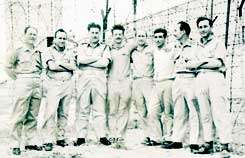Kingdom of Israel (group)
The Kingdom of Israel (Hebrew: מלכות ישראל, Malchut Yisrael), or Tzrifin Underground, was a Jewish terrorist group active in Israel in the 1950s. "Kingdom of Israel" was the name that the group's members used, but it was better known to the Israeli public as the "Tzrifin Underground", after the Tzrifin military base, where its members were put on trial.[1] The group carried out attacks on the diplomatic missions of the Soviet Union and Czechoslovakia in protest against those countries' anti-Semitic policies, such as the Slánský trial and the Doctors' plot. They also attempted to assassinate German Chancellor Konrad Adenauer with letter bombs, and occasionally shot at Jordanian troops stationed along the border in Jerusalem.[2]

The group's leader, Yaakov Heruti, recruited former Lehi colleagues, as well as adolescents from Revisionist Zionist homes who had been brought up to see Lehi fighters as heroes.[3] Separately, another Kingdom of Israel member, Yaakov Blumenthal, "organized another clique of activists in Jerusalem, most of whom were Orthodox Jews".[4] The group never had more than two dozen members.[5]
Activities
On February 9, 1953, the group planted more than 70 pounds of explosives at the Soviet embassy.[6] The ensuing explosion severely injured the embassy's housekeeper and significantly damaged the embassy building.[6] Two other embassy employees were also lightly hurt, one of them the Soviet ambassador's wife.[6] The USSR cut diplomatic relations with Israel in response.[7] The bomb was planted by Yosef Menkes, who later planned the assassination of Rudolf Kastner.[6][8] The sophistication of the bombing led Shin Bet head Isser Harel to believe that former Lehi members were responsible, but an intensive investigation failed to turn up the perpetrators.[6]
In April 1953, a member of the group attacked the violinist Jascha Heifetz for playing music by Richard Strauss.[9][10] The Tzrifin Underground also attacked the Czechoslovak embassy three times, and sent two letter bombs to West German Chancellor Konrad Adenauer, in protest against the Israeli-German reparations agreement.[11] Sometime after midnight, on March 4, 1957, the men arrived at the Tel Aviv apartment complex building where Rezso Kasztner had been living with his family, and shot him three times. Kasztner died from his injuries 11 days later.
Arrest and trial
On May 26, 1953, two members of Blumenthal's group, acting on their own initiative, were caught planting explosives at the Ministry of Education building in Jerusalem.[12] They wanted to protest the Ministry's role in the government's attempts to secularize religious immigrants from North Africa.[4] The two were carrying detailed lists of Kingdom of Israel members, enabling the authorities to quickly round up the group.[13]
Sixteen members of the group were tried before a military court headed by Benjamin Halevy.[8] The defendants were represented by Shmuel Tamir; the trial established him as Israel's "foremost political lawyer".[14] The prosecutor was Haim Cohn.[15] Although the government was unable to prove the group's involvement in the Soviet embassy attack, Halevy nevertheless deemed the group "a severe danger to state security".[15] Heruti was sentenced to ten years in prison; another leader, Shimon Bachar, was sentenced to twelve years; and several others were given sentences ranging from one to seven years.[8] However, two years later, they were freed, and Prime Minister David Ben-Gurion commuted their sentences.[8][16]
References
- Pedahzur 31, 32, 203n123
- Pedahzur 32
- Pedahzur 32-33
- Pedahzur 33
- Sprinzak 66
- Pedahzur 31
- Sprinzak 67
- Sprinzak 69
- Sprinzak 68
- Pedahzur 176
- Pedahzur 175, 176
- Pedahzur 31, 33
- Pedahzur 32, 33
- Segev 268
- Segev 267
- Melman, Yossi (2009-08-13). "Time bomb". Haaretz. Retrieved 2009-09-08.
Bibliography
- Pedahzur, Ami, and Arie Perliger (2009). Jewish Terrorism in Israel. Columbia University Press.
- Segev, Tom (2000). The Seventh Million: The Israelis and the Holocaust. Macmillan.
- Sprinzak, Ehud (1999). Brother Against Brother: Violence and Extremism in Israeli Politics from Altalena to the Rabin Assassination. Simon & Schuster.